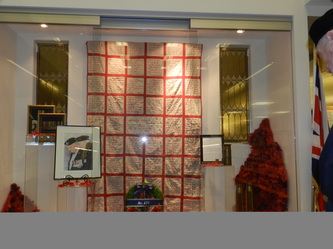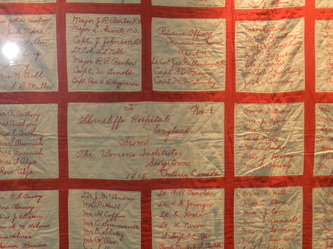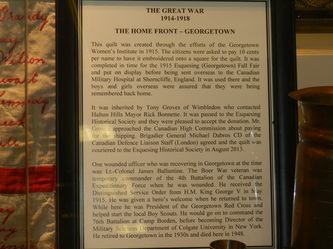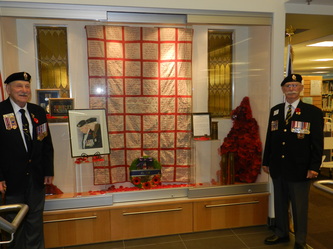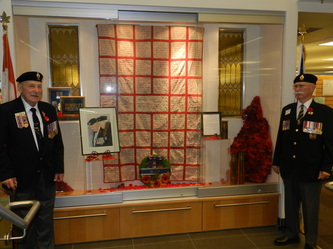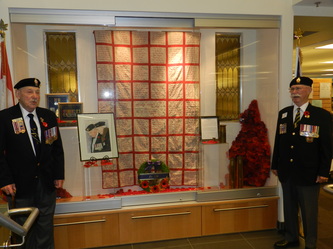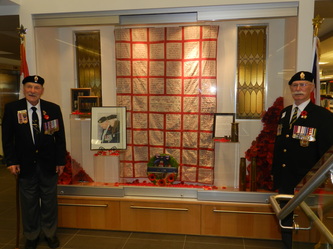ww 1 quilt
Submitted by Georgetown Legion
From the Georgetown Independant
First World War quilt returns … almost 100 years later
By Ted Brown
Staff writer
The year was 1915.
Like the rest of the British Commonwealth, Canada was at war, as countless soldiers were shipped overseas to fight the enemy on the trenched battlefields of Europe.
Back home in Georgetown, various groups were thinking of ways to support those who had signed up and marched off to that faraway war in Europe.
The Georgetown Women’s Institute (WI) decided to create a quilt for those soldiers who had been wounded and were recuperating in hospital in England.
The quilters would never have guessed that nearly 100 years later their labour of love would find its way home.
With war already raging for a year, the WI decided to ‘sell’ space on the quilt, charging everyone 10 cents per name, to have their name embroidered on the quilt.
In an excerpt from The Georgetown Herald’s July 28, 1915 issue, (ironically published one year to the day after war had been declared in Europe), the notice went out to the WI members, asking for help with the quilt.
The excerpt read:
‘Would all interested in the autograph quilt for the Women’s Institute hasten to secure names that all may be worked and returned by the first week in Sept. to give time to complete for exhibition at the fall fair. We would suggest that there be many family, business, and professional groups, anyone at a distance to have their address attached. Names will be repeated as often as ten cents is paid. The quilt is to be sent away to the Canadian Hospital in England and the remainder of the money used by the Institute to secure comforts for the soldiers.’
Obviously, the quilt was completed by September, as it was displayed at the Esquesing Agricultural Society Fall Fair (now Georgetown Agricultural Society) October 6-7, 1915, before being sent overseas.
The finished quilt features 355 names. At 10 cents per name, it raised $35.50 in 1915, which would be equivalent to raising $717.57 in 2013 dollars.
It was sent to Shorncliffe Military Hospital where many wounded Canadian soldiers returned from battle to be patched up and convalesce. The hospital is located just outside Folkestone in Kent, in close proximity to both Dover and Folkestone ports, making it ideal to transport wounded troops from ships.
As we know, The Great War ended with the signing of the Armistice, November 11, 1918.
It’s only speculation, but it’s likely the quilt stayed at Shorncliffe for some time after that as many troops remained in hospitals in England for some time, to grow strong enough to endure the sea voyage back to Canada.
At that point, the trail of the Georgetown Women’s Institute Shorncliffe quilt goes cold.
Fast forward to the spring of 2012.
Norman Jennings and his wife Daisy Nellie were married in the 1930s, and lived in Kingston, Surrey. Daisy died prior to 2012, and in his final days, Norman talked to his nephew Tony Groves of Wimbledon, London, who was the executor of his estate.
He told Groves that he had ‘an army blanket thing in the cupboard’ and he didn’t know what to do with it. Groves never gave it any more thought at the time. After his uncle died April 23, 2012, Groves and his wife Maggie started clearing his uncle’s belongings from his residence.
“We thought no more about it. When he died it was our job to deal with his estate and that’s when we first saw it (the quilt),” said Groves. “It was in the linen cupboard with the sheets and blankets.”
In addition to the 355 names embroidered on the front, the quilt also had the name and address ‘DN Jennings, 23 Orlando Rd SW4’ written in ink on the back.
“I knew that Shorncliffe (hospital) housed the military hospitals for Canadian troops so to that extent I knew what I was looking at,” said Groves in an email interview. “I also noticed that his (his uncle) wife’s address, before they married, was on it, so it must have come through her family. I can only assume that a relative of hers worked at the hospital but that is only a guess.
“So the next question was what to do with it. Sell it? Put it in a drawer for another 100 years?” said Groves. “We made up our minds pretty quickly that if the people of Georgetown made it for their lads all those years ago then they should have it back if they so wished.”
Groves searched online and found Georgetown had become part of Halton Hills. He decided to contact Halton Hills Mayor Rick Bonnette, and asked him if the town had a museum or a group that would be interested in the quilt.
Bonnette forwarded Groves’ query to Esquesing Historical Society (EHS) archivist Mark Rowe, who contacted Groves, May 24, 2012, saying EHS would be quite pleased to accept the quilt.
“I am pleased to hear this item would be of use to you as part of your local history,” replied Groves to Rowe’s email, “It would give me great satisfaction to know that it can be seen by people rather than kept locked away as it has been for such a long while now. Although it is almost 100 years old it is still in very good nick. I have absolutely no idea how my uncle got hold of it and can only assume that one of his family worked at the hospital in the First World War.”
Groves told Rowe he’d investigate the costs and details of having the quilt sent back to Georgetown, and get back to him. The quilt was temporarily placed on hold.
One year to the day later, May 24, 2013, Rowe still hadn’t heard anything from Groves. He emailed him again to see if he’d made any progress.
Groves had been busy settling his uncle’s estate, and the quilt had been somewhat forgotten.
Groves replied quickly, and the quilt repatriation was once again at the forefront.
“I was a little reluctant to put it in the post as I don’t altogether trust any mail service, “said Groves. “I decided to see if it could be sent back through diplomatic channels.”
Groves contacted the Minister of Veterans’ Affairs and explained the situation. Veterans’ Affairs Director General of the Commemoration Division, André Levesque, replied to Groves in an email, saying, “It is heartwarming to learn that you are donating this quilt to the historical society in Halton Hills, Ontario, Canada. Having the quilt come “full circle” after so much time is a truly wonderful moment for all involved.
“With respect to your request for assistance in transporting the quilt to Canada, Veterans Affairs Canada staff contacted the Canadian High Commission in the United Kingdom. I am pleased to advise that the Commission has agreed to arrange for delivery of the quilt from the United Kingdom to Halton Hills.”
Groves was delighted and was told to contact Suzanne Happe, at the Canadian High Commission in London, to work out the details.
Happe contacted Rowe August 13 this year telling him the quilt was on its way.
The best part of the message from Happe was, “At the request of Mr. Tony Groves, the Commander, Brigadier General Michael Dabros CD of Canadian Forces Liaison Staff (London), has agreed to cover the cost of shipping the above historic quilt from the UK back to you for the town of Georgetown from whence it came.”
Consequently, the quilt arrived at Rowe’s residence in mid-August, and everyone involved— Groves, the Canadian High Commission in the UK (embassy), Veterans’ Affairs, and most of all, members of Esquesing Historical Society— were delighted.
For Happe it was one of her final duties at the Canadian High Commission in the UK, as she returned to Canada and retired from the Canadian Forces at the end of August.
“There are some names on the quilt I noticed,” wrote Groves. “I assume that there might be some descendants of those names on the quilt still living in the area.
“I know your lads did well and suffered badly up on Vimy Ridge in 1917 but this (quilt) predates Vimy by two years,” said Groves.
The quilt is now hanging on display in the Georgetown Branch of Halton Hills Public Library, along with a number of artifacts honouring Remembrance Day. It will be displayed in the library until the end of November, then will be taken to Mountainview Residence for a day, to show the veterans who reside there.
From there, it will return to the EHS archives.
The display, a joint effort of EHS, Halton Hills Library and Branch 120 (Georgetown) of the Royal Canadian Legion, was set up October 25.
Branch 120 president Jack Harrison, Halton Hills Public Library staffer Jodie Mandarino and Sheridan College Visual Merchandising student Samantha Babic co-ordinated their efforts to set up the display.
“The whole thing is amazing,” said Harrison. “This (quilt) was done in 1915— almost 100 years ago, and it comes back to town, in amazing shape at that. When I heard about it, I was quite excited, and now that it’s set up on display, it’s wonderful.”
All the players in Georgetown are quite pleased at the outcome of the quilt, making its way back to Georgetown. But the most pleased is Tony Groves.
“I have a great love of military history and I had relatives serving in the armed forces in both world wars,” said Groves. “My uncle is buried in Perth (China Wall) Cemetery in Ypres being killed in 1917. I still have his medals and some of his possessions that were returned to the family.
“We’re not the great and the good,” said Groves, speaking of his wife and himself. “It just seemed right and proper that the quilt, which has survived in such good condition, should go back ‘home’ where it was made all those years ago. It is part of your history and we are so pleased that it will be exhibited so people can see it.”
So the story has gone full circle.
Like an old veteran, the quilt, sent out 98 years ago to fight its own battle— comforting and reminding wounded troops overseas that they were in their families’ hopes and prayers— has done its duty. It’s come home to the safety and respect of the Esquesing Historical Society archives.
And a responsible, amateur historian in Wimbledon has also done his duty, making sure it did return home, where it can inspire memory and respect, as well as once again remind all of the horrors of war— then, now and forever.
First World War quilt returns … almost 100 years later
By Ted Brown
Staff writer
The year was 1915.
Like the rest of the British Commonwealth, Canada was at war, as countless soldiers were shipped overseas to fight the enemy on the trenched battlefields of Europe.
Back home in Georgetown, various groups were thinking of ways to support those who had signed up and marched off to that faraway war in Europe.
The Georgetown Women’s Institute (WI) decided to create a quilt for those soldiers who had been wounded and were recuperating in hospital in England.
The quilters would never have guessed that nearly 100 years later their labour of love would find its way home.
With war already raging for a year, the WI decided to ‘sell’ space on the quilt, charging everyone 10 cents per name, to have their name embroidered on the quilt.
In an excerpt from The Georgetown Herald’s July 28, 1915 issue, (ironically published one year to the day after war had been declared in Europe), the notice went out to the WI members, asking for help with the quilt.
The excerpt read:
‘Would all interested in the autograph quilt for the Women’s Institute hasten to secure names that all may be worked and returned by the first week in Sept. to give time to complete for exhibition at the fall fair. We would suggest that there be many family, business, and professional groups, anyone at a distance to have their address attached. Names will be repeated as often as ten cents is paid. The quilt is to be sent away to the Canadian Hospital in England and the remainder of the money used by the Institute to secure comforts for the soldiers.’
Obviously, the quilt was completed by September, as it was displayed at the Esquesing Agricultural Society Fall Fair (now Georgetown Agricultural Society) October 6-7, 1915, before being sent overseas.
The finished quilt features 355 names. At 10 cents per name, it raised $35.50 in 1915, which would be equivalent to raising $717.57 in 2013 dollars.
It was sent to Shorncliffe Military Hospital where many wounded Canadian soldiers returned from battle to be patched up and convalesce. The hospital is located just outside Folkestone in Kent, in close proximity to both Dover and Folkestone ports, making it ideal to transport wounded troops from ships.
As we know, The Great War ended with the signing of the Armistice, November 11, 1918.
It’s only speculation, but it’s likely the quilt stayed at Shorncliffe for some time after that as many troops remained in hospitals in England for some time, to grow strong enough to endure the sea voyage back to Canada.
At that point, the trail of the Georgetown Women’s Institute Shorncliffe quilt goes cold.
Fast forward to the spring of 2012.
Norman Jennings and his wife Daisy Nellie were married in the 1930s, and lived in Kingston, Surrey. Daisy died prior to 2012, and in his final days, Norman talked to his nephew Tony Groves of Wimbledon, London, who was the executor of his estate.
He told Groves that he had ‘an army blanket thing in the cupboard’ and he didn’t know what to do with it. Groves never gave it any more thought at the time. After his uncle died April 23, 2012, Groves and his wife Maggie started clearing his uncle’s belongings from his residence.
“We thought no more about it. When he died it was our job to deal with his estate and that’s when we first saw it (the quilt),” said Groves. “It was in the linen cupboard with the sheets and blankets.”
In addition to the 355 names embroidered on the front, the quilt also had the name and address ‘DN Jennings, 23 Orlando Rd SW4’ written in ink on the back.
“I knew that Shorncliffe (hospital) housed the military hospitals for Canadian troops so to that extent I knew what I was looking at,” said Groves in an email interview. “I also noticed that his (his uncle) wife’s address, before they married, was on it, so it must have come through her family. I can only assume that a relative of hers worked at the hospital but that is only a guess.
“So the next question was what to do with it. Sell it? Put it in a drawer for another 100 years?” said Groves. “We made up our minds pretty quickly that if the people of Georgetown made it for their lads all those years ago then they should have it back if they so wished.”
Groves searched online and found Georgetown had become part of Halton Hills. He decided to contact Halton Hills Mayor Rick Bonnette, and asked him if the town had a museum or a group that would be interested in the quilt.
Bonnette forwarded Groves’ query to Esquesing Historical Society (EHS) archivist Mark Rowe, who contacted Groves, May 24, 2012, saying EHS would be quite pleased to accept the quilt.
“I am pleased to hear this item would be of use to you as part of your local history,” replied Groves to Rowe’s email, “It would give me great satisfaction to know that it can be seen by people rather than kept locked away as it has been for such a long while now. Although it is almost 100 years old it is still in very good nick. I have absolutely no idea how my uncle got hold of it and can only assume that one of his family worked at the hospital in the First World War.”
Groves told Rowe he’d investigate the costs and details of having the quilt sent back to Georgetown, and get back to him. The quilt was temporarily placed on hold.
One year to the day later, May 24, 2013, Rowe still hadn’t heard anything from Groves. He emailed him again to see if he’d made any progress.
Groves had been busy settling his uncle’s estate, and the quilt had been somewhat forgotten.
Groves replied quickly, and the quilt repatriation was once again at the forefront.
“I was a little reluctant to put it in the post as I don’t altogether trust any mail service, “said Groves. “I decided to see if it could be sent back through diplomatic channels.”
Groves contacted the Minister of Veterans’ Affairs and explained the situation. Veterans’ Affairs Director General of the Commemoration Division, André Levesque, replied to Groves in an email, saying, “It is heartwarming to learn that you are donating this quilt to the historical society in Halton Hills, Ontario, Canada. Having the quilt come “full circle” after so much time is a truly wonderful moment for all involved.
“With respect to your request for assistance in transporting the quilt to Canada, Veterans Affairs Canada staff contacted the Canadian High Commission in the United Kingdom. I am pleased to advise that the Commission has agreed to arrange for delivery of the quilt from the United Kingdom to Halton Hills.”
Groves was delighted and was told to contact Suzanne Happe, at the Canadian High Commission in London, to work out the details.
Happe contacted Rowe August 13 this year telling him the quilt was on its way.
The best part of the message from Happe was, “At the request of Mr. Tony Groves, the Commander, Brigadier General Michael Dabros CD of Canadian Forces Liaison Staff (London), has agreed to cover the cost of shipping the above historic quilt from the UK back to you for the town of Georgetown from whence it came.”
Consequently, the quilt arrived at Rowe’s residence in mid-August, and everyone involved— Groves, the Canadian High Commission in the UK (embassy), Veterans’ Affairs, and most of all, members of Esquesing Historical Society— were delighted.
For Happe it was one of her final duties at the Canadian High Commission in the UK, as she returned to Canada and retired from the Canadian Forces at the end of August.
“There are some names on the quilt I noticed,” wrote Groves. “I assume that there might be some descendants of those names on the quilt still living in the area.
“I know your lads did well and suffered badly up on Vimy Ridge in 1917 but this (quilt) predates Vimy by two years,” said Groves.
The quilt is now hanging on display in the Georgetown Branch of Halton Hills Public Library, along with a number of artifacts honouring Remembrance Day. It will be displayed in the library until the end of November, then will be taken to Mountainview Residence for a day, to show the veterans who reside there.
From there, it will return to the EHS archives.
The display, a joint effort of EHS, Halton Hills Library and Branch 120 (Georgetown) of the Royal Canadian Legion, was set up October 25.
Branch 120 president Jack Harrison, Halton Hills Public Library staffer Jodie Mandarino and Sheridan College Visual Merchandising student Samantha Babic co-ordinated their efforts to set up the display.
“The whole thing is amazing,” said Harrison. “This (quilt) was done in 1915— almost 100 years ago, and it comes back to town, in amazing shape at that. When I heard about it, I was quite excited, and now that it’s set up on display, it’s wonderful.”
All the players in Georgetown are quite pleased at the outcome of the quilt, making its way back to Georgetown. But the most pleased is Tony Groves.
“I have a great love of military history and I had relatives serving in the armed forces in both world wars,” said Groves. “My uncle is buried in Perth (China Wall) Cemetery in Ypres being killed in 1917. I still have his medals and some of his possessions that were returned to the family.
“We’re not the great and the good,” said Groves, speaking of his wife and himself. “It just seemed right and proper that the quilt, which has survived in such good condition, should go back ‘home’ where it was made all those years ago. It is part of your history and we are so pleased that it will be exhibited so people can see it.”
So the story has gone full circle.
Like an old veteran, the quilt, sent out 98 years ago to fight its own battle— comforting and reminding wounded troops overseas that they were in their families’ hopes and prayers— has done its duty. It’s come home to the safety and respect of the Esquesing Historical Society archives.
And a responsible, amateur historian in Wimbledon has also done his duty, making sure it did return home, where it can inspire memory and respect, as well as once again remind all of the horrors of war— then, now and forever.
